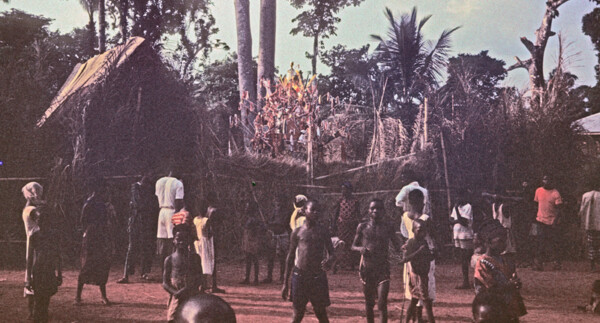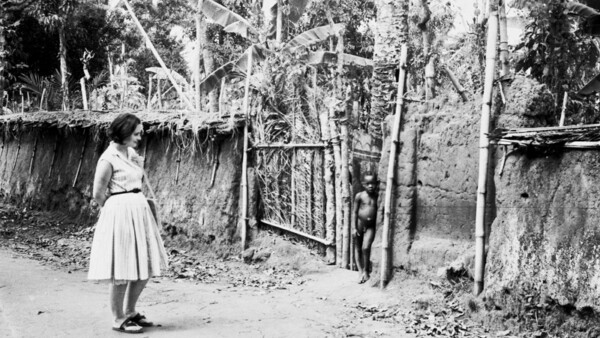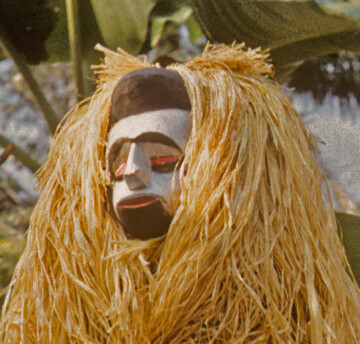It happens that i have three sets of images from Awkuzu: an array taken by me in December 1960, a second set from Januaary 1961, and a much later set courteously sent me by Ukpabi Asika when he acted as Administrator of this area after the Biafra Civil War, in 1970. Asika’s photographs are of consistently high quality; mine are of mostly miserable quality, but I present them anyway because they do have ethnographic value once they have been satisfactorily Photoshopped.
1. December 5, 1960
Recall that this is is just a bit more than two months after we had arrived in Nigeria. Byron Maduegbuna had already become our indispensable guide, and, typically, he notified us on very short notice of the need to travel Now (December 5), since an important event was occurring in Awkuzu town.
Helen accompanied me on this trip, and she took the field notes recording some parats of the event. Her notes from that day indicate what had happpened: a friend of Byron’s, , who was nwa-diani (Daughtrer’s Child) to a woman who was a member of an Awkuzu Village , had been informed that this village was organizing the, presentation of a new Ijele masquerade to the people of Awkuzu. As a loyal Daughter’s Child, he had committed himself to performing an important role in that ritual. He had also informed Byron of the entire matter “at the last minute”, so off the three of us went.
The town of Awkuzu (we would eventually learn) are descendants of an integral participant in the Nri Kingdom origin tradition : according to mythological accounts, Awkuzu was founded in ancient times by the only daughter of Eri, a man whom the Great God Chukwu sent down from the sky at the site of Aguleri, located at end of the uplands where Awkuzu now stands. Eri and his offspring founded the great Nri Kingdom.1
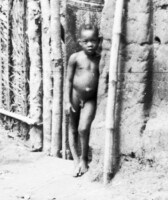

Byron and Helen sit with our own formal offering for this occasion: a bottle of Seidham’s Schnapps, a very desirable gift in much of Igboland. I believe this offering was for Byron’s freind Orizu, a native doctor of some repute with whom Byron’s family had worked in the past. We were hoping to arrange for his kin group to construct a Mmanwu (masquerade) figure for me to send back to the University of California (Berkeley), which had provided me some funds for that purpose.
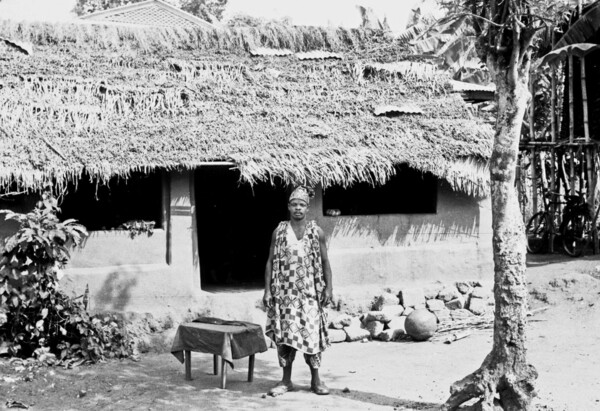
At left, Orizu’s front house (his medical workshop was in the rear). A very modest person in presentation of self, he had a far-reaching reputation. We will encounter hm in more detail in Part 2 of this page.
Byron’s friend was nowmaking the attempt to bring his live cow as a gift to the creators of the masquerade, and as Helen puts it, “to show he is a big man he must also bring his relatives along with him” and they were trooping in to the family house where we were waiting after our arrival. (He had much more trouble with the cow, who apparently stubbornly refused to do as directed.)

Above,, visitors approach the large open space of Awkuzu Village, prearing to witness the Emergence of the city’s greatest masquerade.
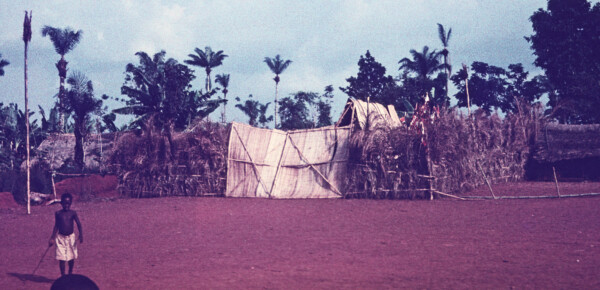
At the far end of the field, an elaborately secret space is set up with elaborate screens and coverings, where secretly selected workers build their crafts beyond the sight of the unkowing public.

At last, when the mysterious form is complete, the crowd falls back (if necessary, pushed by initiated men bearing whips), excitement surges….

At the appropriate time and in its full glory, the giant figure emerges, and it moves! It strides about amidst its admirers, a mighty being indeed. It covers ground, and people give way. ( In this image, you can vaguely make out its legs, for it is carried by one single person.)

The base is a flat, circular platform, around which coils a giant snake, the python (eke), guardian of the sacred earth, the visible base of this walking cosmos.

And see the huge eyes of this monster-in-motion — multi-faceted, insect-eyes, linking our senses to the termite-hill interior pyramid rising in the middle. And with grren arms stretching out to us, we can recognize a mighty tree rising up, while in its branches, around the middle, stand the cretaures of everyday earth, including representations of government officials and their troops, and others.

And toward the top, creatures of higher levels — various birds, and figures of religious import. If I had to guess, I’d say that was Jesus up on top (he has a conspicuous beard), It’s not clear what he’s riding (if anything), he’s too covered with draperies of white cloth.
I confess I don’t remember how long this procession continued. I doubt that it’s humanly possilbe for it to continue for any long time. But after the Emergence, the figure retreats to a more secluded space.

With apologies for the (almost hopelessly) poor quality of this image: in a private space, the dancer emerges, covered with sweat, to wipe himself off before he returns to the public space. (I can’t resist saying, “check out those back muscles!”)
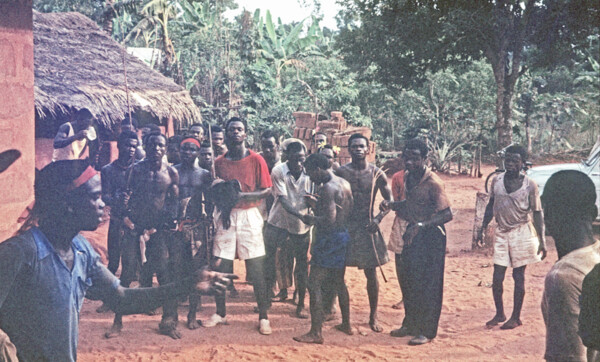
At the end of the performance, the (super)man who has carried the load emerges in the crowd as a normal human being. Here the hero, wearing a red Sweater, carries one of his prizes, the head of a goat, as he walks with his closest airdes. I’m just guessing now, but I wonder if the man walking immediately to his left is Byron’s friend, his cow now safely delivered as his offering in support of the Emergence ritual. Who knows, but at the distance of more than 60 years (this essay is being written in 2021), I wonder who will correct me.

We were taken to meet the Obi of Awkuzu. At left, his Ime-obi (palace), an open, iron-roofed shed with some holes in the roof. Clothes were hanging on a line inside, one of which he said was the robe of office worn by his grandfather.
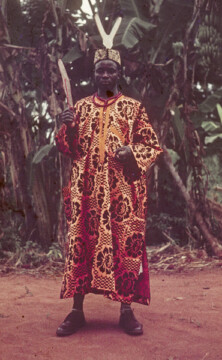
The Obi of Awkuzu wearing the garb he says he wore at his Ofala ritual (in October) . He is 22 years old, and he has been Obi for several months (since the Ofala?) — a very recent crowning. According to him, his grandfather went to Nri , where he was awarded his staff of office. If that’s true, then he’s a descendant of a very hallowed tradition (wee Chapter Two of this volume, page “Niger-Benue….Nri”).
He seemed to be a rather lonely person.
2. January 2, 1961: acquiring Omaba
I will not describe the introductory events on this day, which involved some preliminary rituals of a standard kind (sharing of kola and palm winne, etc), but the mmanwu-iniitiated elders of Umudei (Orizzu’s village in Awkuzu) wanted to have a photograph of the occasion, which I present here below. Some of them are quite young, but the point is that all of them have been initiated into the mmanwu cult.
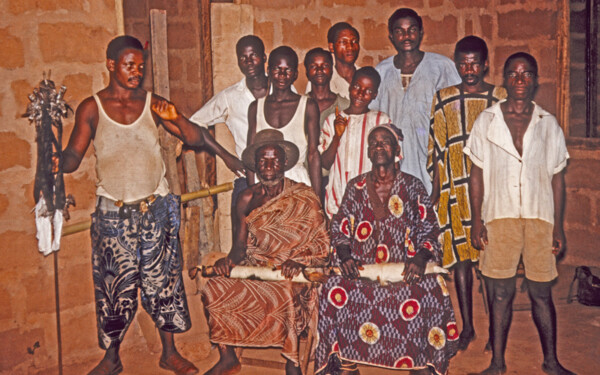
Orizu stands at far left, bearing his medicinal staff. (I am unsure of what the white objects the two seated persons hold here,, but I think they are emblems of their titled positions, perhaps pieces of ivry tusk.) The standing men are of various ages, but all presumably untitled.
On this occasion, Orizu dellivered a considerable speech in praise of my generosity in funding their enterprise, thanking me for my interest in his people’s culture, and voicing the villagers’ hopes that one day I may take title in their family. I then gave my response (clumsy as usual), but fortunately Byron was present to translate with considerable elaboration and much dramatic effect. This was typical in my experience of occasions like this: artistic oratorical displays that continue for a considerable time are essential parts of the process, there’s an Igbo proverb for it that mostly escapes me right now — something like the sauce that makes the traditional poounded yam food so delicious.
We participants in Umudei activities were standing about admiring the figure when an elderly woman returning from the marketplace passed along a nearby pathway and looked over and saw us. She was so alarmed that she almost lost her head-load, crying out in alarm. (Orizu had arranged to bring the mmanwu out while the women werre at market. It is a figure of great respect, normal only seen at events of major importance.
I confess that I was quite delighted to view this creature, and seeing it again today I find the view quite beautiful. I’ve never seen anything much like it, and I wonder how similar it is to the other Omaba from this village, that the faces at any rate are probably rather distinctive, and I’ll explain why further below.

I asked Orizu about the translation of Omaba and he called it “Evil Spirit”. I doubt this is at all literal, but this village of Umudei in Awkuzu is renown for practicioners of what Byron calls “The Black Arts” (lit. ikonsi, “throwing poison”.), though I think the “medicine” side of his practice is much broader than this label.
Orizu’s medicinal staff is a very unusual one. I attach of view of it here, though unfortunately the details are not well focused.
But this masquerade is also an unusually important one: it comes out for the first and second “burial” (Lamentation) of titled men or “great warriors”, meaning that it’s an equivalent of the Ndi-Onicha very important figure, the mmuo afia or mmuo ogonogo. These beings escort the newly deceased to the Land of the Dead, and later emerge (at the culmination of the Lamentation) as the person’s new, now ancestral personality.
Here I must insert another story referring to a location entirely elsewhere, and this concerns directly myself. This memory is exremely embarrassing and chagrining to me, but I think the point is worth making. I stated above some questions about the particular form of the particular Omaba that was made for and then presented to me. On another occasion, I saw at Nsugbe town a particular Ikenga figure that I very much admired.
The ikenga is a personal deity acquired mainly by men , that represents a person’s will to achieve, to accomplish desired goals. Typically itss head bears the horns of a ram –rams are infamous for butting their way forward. The figure’s right hand holds the means of accomplishment (typically, a large knife) and its left hand grasps the results of on e’s efforts, typically an ivory horn (or some other valuable object).

On a visit to Nsugbe (described in this chapter,on the page entitled “Visit to Nsugbe…..”), I became enthralled with a particular Ikenga statue (shown here at left). I learned of its maker, and arranged with Byron to contact him a see if he could make a similar one for me. The man agreed to do this, and on a later trip we returned to acquire it.
(Set aside the very complex elaboration of the crown, which points to some high title; I was mainly struck by the form of the main body of this figure, its combinations of form. i emphasized the beauty of the body while talking to the artist.)
The artist brought out a figure, so entirely different from the one I had pointed out to him (at left) that I find myself grasping for comparisons. The figure, holding small objects (I don’t remember what) had startlingly child-like and exaggerated European features, and of course the body color was pale, the dress was European style. It struck me as an insulting cartoon, and I felt like my very self was being ridiculed in some kind of way., I blustered; Byron said, “I think it’s very fine”, but I simply stomped away.
As I might have understood, original African artists are not primarily copyists of things done by others. True, they work in certain traditional styles, but an Ikenga is an image of a person, and this artist was trying to limn the character in light of what he knew. He did not respond in the rote fashion I had presumed. At the very least, I should have accepted it for his view of what I might be as a person, but instead I stomped awy, deeply offended somehow. My self was simply too insecure at that time to do the anthropologically insightful thing — accept the effort as a valid expression of an artist’s view of the world as he understood it.
Later that day, when Byron and I were driving back to Onitsha, Byron claimed to me that Orizu was able to arrange this construction of a mmanwu for me because “everyone is afraid of him” — because, as a dibia [native doctor] he must be an expert in iku-nsi [hitting with poison] . And you know (he continued), such a man, though he be very wealthy, will have very few children. Why? For two reasons: one, “the practice requires frequent abstentions from sexual intercourse, because a woman’s properties will ruin the poison.” And second, “there is some kind of (occult) connection between the Black Arts and sexual powers.” Orizu at the time had only one son. Byron concluded by observing that most Onitsha men “cannot do the Black Art”, so they must go to “bush” places and recruit experts if they want to get it. (I might add that many Onitsha men are not a little proud of their sexual prowess.)
3. Awkuzu Ijele presented 1970 (post-Civil War
After the end of the failed Biafra War of Secession by the government of the Eastern Region of Nigeria, the (American-educated political scientist) Ukpabi Asikka was designated Administrator of the Region, and one of his efforts to re-integrate people into historically recognizable social life was to organize some formerly prominent social events. One of these was the presentation of the historically-renown Awkuzu Ijele. Mr. Asika kindly sent me some pictures taken of the event, which I gratefully present here.

Here, Mr. Asika (dressed in a dark European-style suit) observes the Emergence of the figure. He is surrounde d by a large group of fellow male observers. Note how the ciircular base stands out at thiis distance.
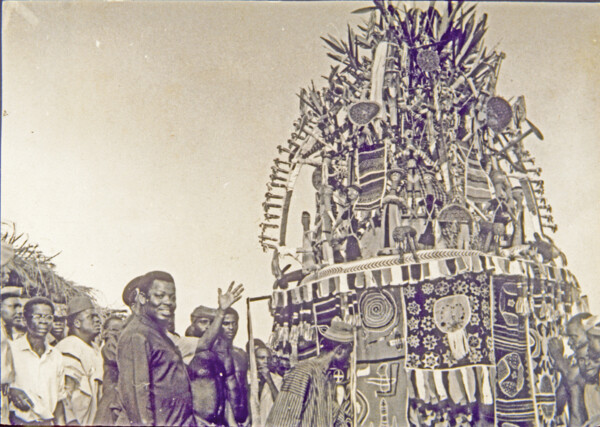
Here he presents the figure for closer observation. The “coiled python” is here represented by an abstractly-decorated strip of cloth riding on the base. In the main body of the figure above the base, the conical mound is large, the standing figures are small but they are clearly alll Africans (no European officials evident). The multifaceted insect-eyes of the figure are prominent, and the tree aspect is greatly emphasized in the form of many leaves. The strips of cloth below the base look similar to the earlier form.

The apex figure continues to wear what looks like a pith helmet, and is dressed in white cloth. It’s unclear whether he is riding any thing. He appears to be holding some large object or objects in his hands. But it’s also clear that he is black — not some colonial-syle administrator.
- See Chapter Two, Deep-searching History, for more details. [↩]
